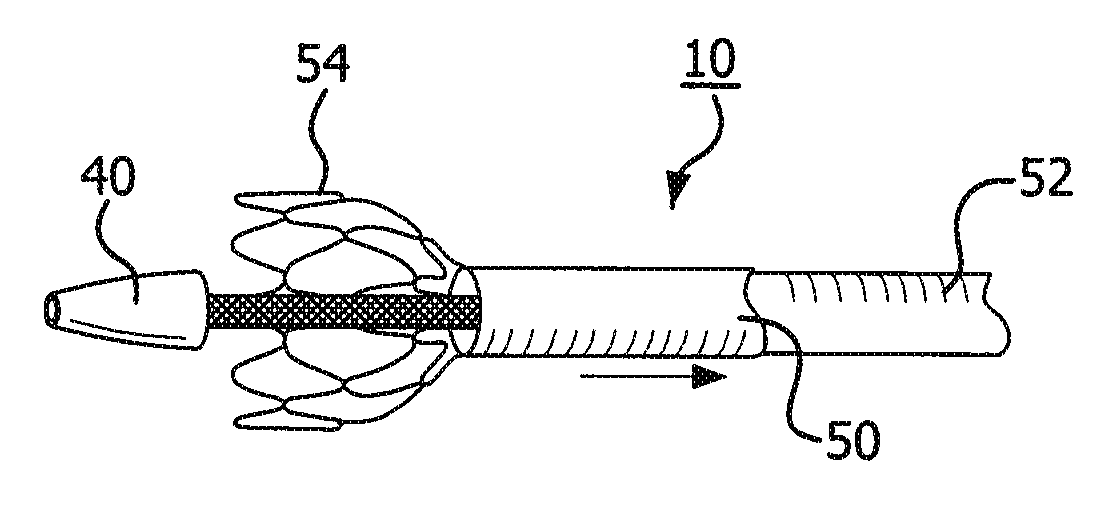Tube with reverse necking properties
a tubular structure and reverse necking technology, applied in the field of tubular structure improvement, can solve the problems of difficult or impossible to slide the plastic wrap off the mandrel, the necking can be problematic, and the mandrel is difficult or impossible to be slid off, so as to increase the diameter of the tube, increase the diameter, and increase the diameter
- Summary
- Abstract
- Description
- Claims
- Application Information
AI Technical Summary
Benefits of technology
Problems solved by technology
Method used
Image
Examples
example 1
Uniaxially Oriented ePTFE Film
[0066]This Example describes the assembly of an ePTFE tube that can be easily removed from an assembly mandrel. On a 0.136″ steel mandrel a 1″ wide expanded polytetrafluroethylene (ePTFE) film (having longitudinally oriented strength, minimal transverse and shear strength, and with FEP on one side functioning as an adhesive) was wrapped at 40° pitch relative to the mandrel axis in a right handed helix orientation with the FEP facing away from the mandrel. Next, a 0.25″ wide ePTFE film was wrapped at a 74° pitch in a right handed helix orientation over of the first film with the FEP facing toward the mandrel. The assembly was then thermally processed on-mandrel at a temperature of 320° C. for 13 minutes. The tube was easily removed from the mandrel and no necking was observed at loads below material yield strength.
example 2
Uniaxially Oriented ePTFE Film with Polyimide Film
[0067]This Example describes the assembly of an ePTFE tube comprising a non-compliant polyimide film (Kapton®) between the ePTFE layers. On a 0.236″ steel mandrel a 1.0″ wide ePTFE film was wrapped at a 56° pitch relative to the mandrel axis in a right handed helix orientation with the FEP facing away from the mandrel. Next, a 0.050″×0.001″ polyimide film was wrapped at 82° pitch relative to the mandrel axis at a right handed helix orientation over of the first film. Then a 1″ wide ePTFE film was wrapped at a 56° pitch relative to the mandrel axis at a right handed helix orientation on top of the polyimide film with the FEP facing toward the mandrel. The assembly was then thermally processed on-mandrel at a temperature of 320° C. for 13 minutes, after which tube was removed from the mandrel.
[0068]The non-compliant polyimide film used for high angle wrap limits axial strain and allows the use of a higher angle ePTFE wrap. The higher a...
example 3
Uniaxially Oriented ePTFE Film with Polyimide Film
[0069]To see if the tube made in Example 2 can be modified to reduce necking, slits were created with a knife into the ePTFE in an orientation parallel that of the film structure (56° pitch relative to the mandrel axis), with approximately 0.050″ spacing between the slits. These slits eliminate “off-axis” strength of ePTFE film allowing diametric growth of the polyimide helix under tension without ePTFE necking. Thus, the introduction of these slits eliminates necking.
PUM
 Login to View More
Login to View More Abstract
Description
Claims
Application Information
 Login to View More
Login to View More - R&D
- Intellectual Property
- Life Sciences
- Materials
- Tech Scout
- Unparalleled Data Quality
- Higher Quality Content
- 60% Fewer Hallucinations
Browse by: Latest US Patents, China's latest patents, Technical Efficacy Thesaurus, Application Domain, Technology Topic, Popular Technical Reports.
© 2025 PatSnap. All rights reserved.Legal|Privacy policy|Modern Slavery Act Transparency Statement|Sitemap|About US| Contact US: help@patsnap.com



